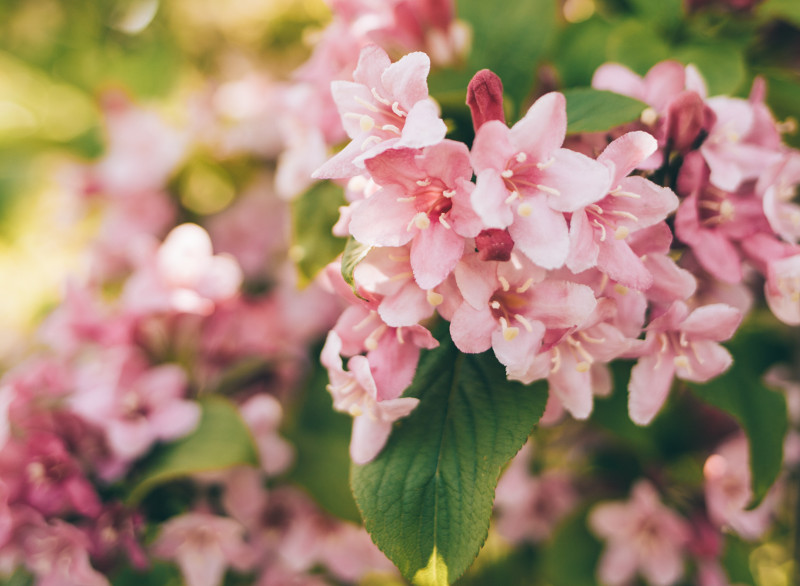
Weigela
Uses:
- Specimen or Focal Point
- Flowering Borders
- Wildlife Gardens
Features:
- Attracts Hummingbirds
- Early Spring Blooms
- Low Maintenance
Sunlight:
- Partial Sun to Full Sun
- 5+ Hours of Direct Sun
Growing Zones:
- 4-8
- What is My Zone?
Weigela are flowering shrubs that bloom profusely in the spring time and rebloom through the summer. The trumpet-like flowers are a favorite for hummingbirds. The shrubs are low maintenance & deer resistant and becoming more and more popular in gardens.
About Weigela

Weigela
Eastern Asia
Bushes
Deciduous
4-8
Pink, Red, White, Purple
Spring to early summer
Upright, Spreading
Hummingbirds, Butterflies
Drought, Heat
Deer, Pests
How To Use Weigela In The Garden
Weigelas produce copious tubular blooms in pink, white, purple or red and attract bees, hummingbirds, and butterflies. The long flowering period often includes one or more reblooms until frost. The arching branches, combined with colorful foliage that ranges from green to variegated or burgundy tones, provide visual interest even when not in bloom. This hardy plant adapts well to various soil types and is valued for its ease of care.
In landscape design, weigela is ideal for creating low-maintenance hedges or backdrops for perennial borders. Its spreading growth habit makes it suitable for filling larger spaces or adding texture to slopes. Compact varieties thrive in containers or smaller gardens as accents, while taller types serve as excellent windbreaks or boundary markers. Planting it alongside contrasting greenery enhances its appeal and brings depth to the garden layout.
We offer the largest online selection of weigela and mainly sell Weigela florida, which is a species native to North China, Korea and Japan. These are non-invasive in the United States. Our most popular shrubs are the dwarf varieties, which make fabulous container plants.
Landscaping Tip: Weigela attract hummingbirds and butterflies, so place them within view of a window so that you can enjoy the display whether indoors or out.
Weigelas Care
Weigelas perform best when placed in well-draining soil with a slightly acidic to neutral pH. Full sun exposure is ideal for encouraging healthy growth and an abundance of flowers, though they can tolerate light shade. When planting, space them adequately to allow airflow, which reduces the risk of disease. Water consistently, especially during the first year, to help roots establish, but avoid overwatering as soggy soil can lead to root rot. Use a balanced, slow-release fertilizer in early spring to promote vigorous development throughout the growing season.
In colder regions, apply a layer of mulch around the base to protect roots during winter. Growing in containers is also an option; choose a pot with drainage holes and fill it with a well-drained, high-quality potting mix. Bring the container to a sheltered area during frost periods.
Pruning Weigelas
The best time to do any major structural pruning is in early spring while the weigela is still dormant. Remove up to one third of the oldest branches by cutting them back to the base of the shrub. Also prune off any dead growth and winter dieback. Keep in mind that weigelas bloom on old and new wood, so removing branches during this time will reduce spring blooming.
Once the weigela blooms in spring, you can lightly prune for shape. Cut back branches with spent blooms, removing no more than one third of the top growth. Weigelas will often rebloom on new wood, especially the newer varieties, so pruning at this time can reduce repeat blooming later in the season. The tradeoff is that pruning stimulates new growth and can result in a healthier shrub, especially for older, overgrown specimens.

Weigela Companion Plants
Plants that go well with weigela are annuals, perennials and shrubs that need plenty of sunlight and well drained but moist soil. Some of our favorite plants to grow with weigela shrubs in the garden are hydrangeas, viburnum, lilacs, bee balm, coneflowers, salvia, impatiens and fuschia. Many of those plants also attract hummingbirds, which make pairing those plants work so well.






































